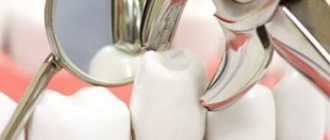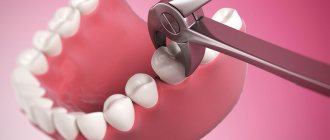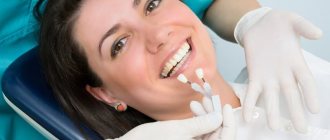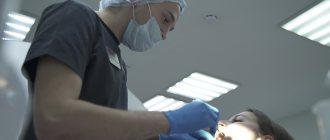Tooth extraction is carried out plannedly, as well as for emergency indications.
The main indications for planned tooth extraction: complete or severe destruction of the tooth crown and the inability to use it for prosthetics, chronic periodontitis that is not amenable to conservative treatment, grade III tooth mobility in periodontal diseases, and others.
Urgent tooth extraction is indicated for purulent periodontitis, acute osteomyelitis, periostitis, sinusitis, lymphadenitis (if the source is a diseased tooth), fracture of the tooth crown exposing the pulp and some other diseases and conditions.
Removing various teeth has some of its own characteristics, for example, removing teeth with a crown is somewhat simpler than removing tooth roots. The extraction technique for the teeth of the upper and lower jaws, incisors and molars is also slightly different.
Types of tooth extraction
In medical practice, all removal procedures are divided into:
Easy removal
The doctor manages to extract the entire tooth using special forceps; its duration is up to 5 minutes. This is how single-rooted teeth or teeth affected by periodontitis are removed.
Difficult removal
To extract a tooth, the doctor uses auxiliary tools (most often an elevator), and the entire extraction process takes up to 15 minutes. It is most often performed when a part of the root or crown is broken during the removal of multi-rooted teeth.
Atypical removal
It has no clear boundaries in terms of time and extraction method and implies a complex and multi-stage procedure. For this, the doctor can use a bur, an elevator, forceps, a chisel, surgical sutures and needles to close the wound. Often such removal requires from 30 minutes to 2 hours.
This division is reflected both in the cost of the removal itself (due to the various labor costs of the doctor) and in the rehabilitation period:
Simple removal results in minimal damage to surrounding tissue. At the same time, squeezing them with an instrument (and stopping full blood circulation in this area) lasts no more than 5 minutes, and does not in any way affect the subsequent healing of the wound. If you follow the recommendations, the risk of complications is minimal.
Complex removal involves the use of more aggressive instruments and prolonged compression of the walls of the bone alveolus. After it, there may be difficulties with the formation of a blood clot and the development of alveolitis of the “dry socket” type, which is supervised by taking anti-inflammatory drugs and applying turunda with iodoform.
Atypical removal is a surgical intervention in which the doctor violates the integrity of the mucosa, periosteum, or a certain part of the bone. Pressure on tissue can last up to 2 hours, which greatly affects tissue microcirculation. Sometimes a hemostatic sponge is used to stop socket bleeding during such removal. The wound is sutured, which ensures the tightness of the hole and protects it from the development of alveolitis, but it is important to maintain a hygienic regime to avoid infection on the soft tissue.
The doctor’s further tactics, his prescriptions and recommendations for the recovery period depend on how the tooth was removed.
Is it necessary to place an implant if there is no six?
The upper and lower sixes, despite their strength, are more susceptible to mechanical stress and exposure to the bacterial environment than other dental units. Molars are one of the first teeth a person loses. The dental system is designed in such a way that almost immediately after the loss of a tooth, the bone tissue in this place begins to decrease.
The absence of the sixth tooth is accompanied by the following problems:
- the abrasion of the frontal group increases;
- the dentition shifts - neighboring units move towards the missing one;
- antagonists move forward - on the opposite jaw the second molar leans forward;
- tilting of the teeth contributes to the appearance of a wedge-shaped defect, exposure of the roots and displacement of the dental axis;
- the chewing load, which previously fell on 6, is redistributed to other units (adjacent premolars, molars);
- occlusion and chewing function are impaired;
- When the occlusion is violated, excessive chewing pressure is created, accelerating bone loss in the area of the missing tooth.
Considering the importance of the six as a supporting chewing unit, you need to immediately think about how to replace it. Implantation is considered a physiological, long-lasting way to replace teeth. Traditional prosthetic methods do not prevent bone loss. Implant-supported dentures are the only way to restore full functionality of the dentition.
How is tooth extraction performed?
Before removal, the doctor conducts a survey to find out if the patient is allergic to anesthetics and medications. The doctor also asks the patient about the presence of trophic diseases (diabetes mellitus, atherosclerosis) and pathologies of the cardiovascular system (hypertension, arrhythmia, etc.). This is necessary for the correct selection of anesthesia.
Then the doctor administers anesthesia (usually conductive torus for the lower jaw and infiltration for the upper jaw) and waits for the effect to occur.
Simple removal consists of 5 steps:
- applying forceps to the tooth;
- moving them so that the cheeks are under the gum;
- tool fixation;
- luxation (swinging) - necessary to detach the periodontal ligament, which holds the tooth in the bone;
- traction (luxation) - removal of a tooth from the alveolus. This is done by tilting the tooth in the direction of least resistance (where the alveolar wall is thinner) and simultaneously pulling the tooth outward.
For complex extractions, the doctor uses an elevator - a chisel-shaped instrument with a pointed end, which is carefully inserted into the hole and, with its help, pushes the tooth out from the top of the root.
In the process of atypical removal, a surgical field is formed: the doctor dissects the mucous membrane, peels off the flap with the periosteum and removes the bone substance located above the tooth. The tooth itself is removed using an elevator, but often during the removal of wisdom teeth, the doctor is forced to saw it into pieces with a drill, extracting each root and crown separately.
Why do sixth teeth need restoration more often than others?
The sixth teeth (or first molars according to dental classification) are classified as molars. They are laid at the 5th month of intrauterine development, mineralization begins from the 9th month of the intrauterine period, and continues for another month after the birth of the child. The enamel of the “tooth germs” located in the jaw bone finally matures by 1-2 years. The correct formation of molars depends on the course of pregnancy and childbirth.
Molars do not appear at an early age; they do not have predecessors (baby teeth). They begin to erupt at 5-6 years of age, the first of the permanent radical units. The structure of the first molars differs from other teeth of the chewing group - the maxillary sixes have three roots and four canals, the mandibular sixes have two roots and three canals. These are the largest molars, characterized by a wide tuberous surface.
The chewing group, in particular the first molars, are most susceptible to the destructive effects of bacteria and excessive mechanical stress. This is the main cause of irreversible damage to the tooth structure and its loss.
Recommendations after removal
Regardless of the method by which the tooth was removed, in the first 2 days the patient must observe a special diet, activity and hygiene. This is necessary to preserve the blood clot in the wound, which helps maintain the sterility of bone tissue and promotes its regeneration.
In the first 48 hours after removal you cannot:
|
Failure to comply with these recommendations most often causes the clot to fall out of the socket and the development of alveolitis or bleeding.
After tooth extraction it is recommended:
- make oral baths from chamomile and sage decoctions (the decoction prepared according to the instructions is taken into the mouth and held there for 10 minutes, without rinsing or moving the tongue) 2-3 times a day;
- take non-steroidal anti-inflammatory drugs (especially after atypical removal, when the tissue is severely damaged and swelling occurs) - nimesulide, diclofenac sodium, ibuprofen, paracetamol, etc. (it is important that the medicine does not reduce blood clotting).
Sometimes patients need preliminary preparation for removal. People taking aspirin and other medications that impair blood clotting should stop taking them a week before the procedure. For those who suffer from increased excitability and anxiety, you can start taking valerian or motherwort 1-2 weeks before removal, having previously agreed with your dentist and your therapist.
Even if the removal was painless and quick, you should not ignore the doctor’s advice. The right approach to rehabilitation will help you avoid complications and recover faster.
Operation procedure
The standard (simple) scheme for removing the upper tooth includes the following measures:
- a medical history examination, during which the surgeon makes sure that the patient has no contraindications to the operation;
- referring the patient for an X-ray examination and subsequent study of the resulting images;
- injection of local anesthetics;
- detachment of the gums adjacent to the enamel using a smoothing iron or a rasp;
- grasping the diseased tooth with the cheeks of dental forceps and dislocating it by rocking or rotating around an axis;
- extraction of teeth and movable bone fragments from the alveolus;
- sanitation of the alveolar socket (tissue treatment with antiseptic and anti-inflammatory agents, removal of cystic neoplasms, granulomas, etc.);
- suturing (if necessary).
Simple extraction is carried out in cases where the dental crown is well visualized, and the surgeon has the ability to securely grasp it with the cheeks of dental forceps. In case of incomplete eruption of the tooth, its increased fragility, the absence of its crown part, as well as significant curvature of the tooth roots, surgical (complex) removal is performed. In this case, the doctor can cut the gums, drill out bone tissue, divide the crown into lobes and take other measures designed to facilitate the procedure of removing the upper incisor, canine, molar or premolar from the alveolus.
Contraindications to the procedure
You should temporarily avoid deleting:
- with a decrease in blood clotting, which was caused by taking medications or the onset of menstruation;
- after suffering a hypertensive crisis, heart attack, infectious diseases;
- with severe heart rhythm disturbances;
- during gestation (if there are serious indications, surgical intervention is allowed in the second trimester).
If a patient has hemophilia or mental disorders, the operation is performed only in an inpatient setting.
Postoperative care
After the operation is completed, the surgeon books the patient for a preventive examination and dressing, prescribes anti-inflammatory, antihistamine, antibacterial and painkillers. In addition, the doctor explains to the patient how to properly care for the postoperative wound. In particular, the surgeon may recommend:
- refuse food for 3 hours after surgery;
- ensure that the wound surface is not injured when chewing food, rinsing the mouth, brushing the teeth with a brush, floss or toothpick, etc.;
- refrain from hot drinks, alcohol, cigarettes, excessively salty, sweet, hard or spicy foods for 3 days after the procedure;
- Avoid physical activity, visiting a bathhouse or solarium for a week.
The appearance of heavy bleeding or purulent discharge from the alveolar socket, the development of inflammatory processes and severe pain in the postoperative wound area are signs of complications of the procedure. If they are identified, it is necessary to contact the surgeon who performed the operation and undergo comprehensive treatment according to the scheme drawn up by him.
Prices for tooth extraction
| Name | Price |
| Consultation | For free |
| Use of bone material | 4,000 rub. |
| Simple tooth extraction | 2,700 rub. |
| Removal of periodontitis tooth | 1,000 rub. |
| Tooth extraction is complicated | 3,200 rub. |
| Removal of a dystopic wisdom tooth | 4,000 rub. |
| Removing a tooth fragment | 500 rub. |
| Removal of exostosis in the area of 1 tooth | 2,500 rub. |
| Removal of cysts and benign formations | 3,500 rub. |
| Treatment of alveolitis | 1,200 rub. |
| Lengthening the clinical crown of a tooth | 5,000 rub. |
| Free flap gum grafting | 8,000 rub. |
| Removing stones from the ducts of the salivary glands | 3,500 rub. |
| Splinting for a jaw fracture | 15,000 rub. |
| Socket curettage | 200 rub. |
| Filling the hole with a medicinal substance (Alvogil, al-vostaz, hemostatic sponge) | 200 rub. |
| Resection of the apex of the tooth root | 4,500 rub. |
| Removing a foreign body from the canal | 1,500 rub. |
Possible complications after tooth extraction
Complications can appear during surgery, as well as after it, and can be local or general. General: fainting, rarely – shock. Their cause is the patient’s psycho-emotional stress, sometimes pain due to poor-quality anesthesia.
Local complications:
- Fracture of the tooth being removed (crown or root);
- Dislocation or fracture of a nearby tooth;
- Trauma to the soft tissues of the oral cavity;
- Dislocation or fracture of the jaw;
- Perforation of the bottom of the paranasal sinus;
- Pushing the tooth root into the maxillary sinus;
- Bleeding;
- Alveolitis.
Contraindications
Before removing a tooth from above, the doctor conducts a diagnosis, identifying the presence of contraindications in the patient. If a person has acute infectious inflammation, the acute phase of mental illness, diabetes mellitus, systemic diseases of the heart muscle or poor blood clotting, extraction is not performed. It is not indicated in the first and last months of pregnancy, when women begin their periods. If contraindications are identified, the surgeon postpones the operation to a more favorable moment.
What is the difference between implantation on the upper and lower jaw?
Features of the operation from below
Implantation of the 6th tooth from below is performed using a two-stage method with delayed loading. The implant is implanted using the patchwork method. The crown is installed on the abutment after the artificial root has healed (after 2-4 months). Features of implantation are associated with the anatomical structure of the mandibular structures:
- high jaw bone density - the implant takes root faster, its good primary stability is achieved;
- bone tissue is stronger, therefore it decreases more slowly than in the upper jaw;
- the volume of the mandibular bone is anatomically higher - there are more opportunities to replace the lower tooth without tissue expansion;
- absence of sinuses - there is no risk of injuring the membrane of the maxillary sinus during implantation.
But the trigeminal nerve passes through the base of the lower jaw; if the bone atrophies, it can be damaged (if the technology of the implantation protocol is violated).
Installation of the implant from above
Implantation of the first molars of the upper jaw also has features associated with the anatomy of the jaw structures. The upper teeth are located close to the sinuses (maxillary sinuses), damage to which is accompanied by serious consequences. The maxillary bone is looser and thinner, so it decreases very quickly, and implants take 1-2 months longer to take root than in the lower jaw.
- The choice of method for implanting first molars is a two-stage protocol with a break for osseointegration of the titanium root. The average healing time for upper jaw implants is 4.5 months.
- Since the classical protocol requires sufficient volume and good quality of bone tissue, treatment is often complemented by osteoplastic surgery (sinus lift).
- When making prosthetics, the increased mesiodistal space and the distribution of occlusal forces are taken into account.
Why do you need to remove a cyst?
Patients sometimes do not want to resort to surgery, claiming that the tumor does not cause discomfort. Yes, the development of a cyst is asymptomatic. But it begins to destroy the root of the adjacent tooth, and then the surrounding tissue. And instead of timely basic surgery, you have to perform complex manipulations that threaten complications.
Another point:
If you do not remove the dental cyst while it is still forming (the cost will be determined by the attending physician), then there is a possibility of its degeneration into a malignant tumor.
Come for a consultation, and we will decide what steps you need to take specifically in your situation, whether you can save the tooth or need to remove it, we will take pictures to identify a cyst or granuloma. Fast, comfortable, pain-free.
Is it painful to remove molars?
Today, only older people remember the terrible pain during the removal of molars. Nowadays, the quality of painkillers is so high that the patient does not feel pain at all, even with difficult removal. At the same time, after the anesthesia wears off, pain, of course, occurs, but it is quite tolerable and depends on how much the gum under the tooth was disturbed.
If the pain is still severe, then the dentist recommends taking a painkiller tablet. The same analgin successfully dulls pain for a long time.
In rare cases, the patient may experience throbbing and increasing pain. This annoying phenomenon occurs due to inflammation of the socket. If measures are not taken quickly, the tissue begins to fester in the hole. This process can be suppressed with drug treatment, but sometimes you have to open the gum and clean the hole from pus.
Why remove teeth before starting orthodontic treatment and installing braces?
Why remove teeth before installing braces?
Patients ask this question to the doctor as soon as they hear about the need for this procedure. The answer to this is quite simple: in order for the teeth to align in a row and take the correct position, they must move in a certain way under the action of braces. But this shift requires not only a certain pressure created by braces, but also free space, which may not exist with severe crowding of teeth, with an abnormal jaw structure, or with the presence of extra teeth in a row. Then this space is created artificially and this is why teeth are removed. Sometimes tooth extraction before installing braces is indicated as a preparatory procedure for a course of correction.
Wearing braces complicates oral hygiene and increases the risk of developing a variety of dental diseases. These risks will be even higher if there are decayed teeth in the mouth, with inflammation in the root part. Such teeth must be treated before installing braces, and if this is not possible, then their removal is prescribed.
USEFUL TO KNOW: Removing a diseased tooth while wearing braces requires removing the structure from the teeth, and also leads to a significant increase in the overall treatment time!
After three days
The blood clot begins to change and thicken. Gray and white fibrin stripes appear on it, after which the formation of new gum tissue begins. Painful sensations may still occur. But they are much weaker and have a pulling character. The patient may experience bad breath. This is considered normal and is due to the formation of a blood clot. Failure to brush your teeth also leads to the formation of bacteria and an unpleasant odor.
To rinse the mouth, you must use special solutions recommended by your doctor. The appearance of pain from touching the gums, increased pain during eating, serves as a signal for the need to return to the dentist's office. If the tissue of the edges of the hole has acquired a red tint, you should also immediately consult a specialist.










